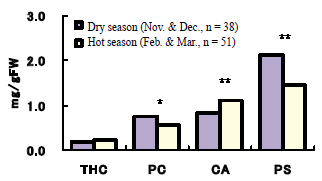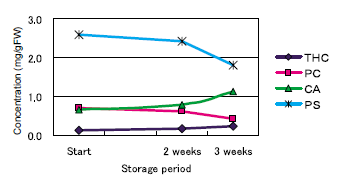Seasonal variation in the functional polyphenol contents of fingerroot (Boesenbergia pandurata (Roxb.) Schltr.) available in Thai markets
Description
Fingerroot (Boesenbergia pandurata (Roxb.) Schltr.) is a member of Zingiberaceae and is sold as a spice in fresh vegetable markets in Thailand. Rhizomes of fingerroot contain high levels of polyphenols, including 2’,4’,6’-trihydroxychalcon (THC), pinocembrin (PC), cardamonin (CA), and pinostrobin (PS). These compounds have clear health benefits due to their anti-mutagenic or antitumor actions. However, the concentrations of the polyphenols varied considerably in the samples we obtained in Thai markets. Although the primary cause of such variation appears to be varietal, we found an additional key factor, that of seasonal differences. Fig. 1 illustrates this. Based on the average of all our samples from the researched markets, THC and CA increase and PC and PS decrease statistically significantly at the beginning of the hot season (February-March), compared to the levels in the early dry season (November- December). Fingerroot is usually planted at the beginning of the rainy season (April- May) and grows during the rainy season (May-October). The samples in the early dry season were thus relatively fresh, and the samples from the beginning of the hot season had been stored for four or five months. We also researched four fingerroot farmers in different places in northeastern Thailand during the same seasons as part of our market research. The fingerroot in their gardens showed the same season-dependent changes in the four above-mentioned polyphenols as the samples from the markets. These facts suggest that the seasonal changes in the polyphenols in the markets occurred during the storage of fingerroot under the ground. To test this, we stored fresh fingerroot from the early dry season for three weeks in plastic bags at 4 ℃, and traced the changes in concentrations of the four polyphenols. Fig. 2 shows the results. During storage, THC and CA increased and PC and PS decreased in the same way as seen in the markets and the garden samples. In conclusion, to be able to utilize the abundant functional polyphenols in fingerroot, fresher products (at the beginning of the dry season) are better for supplying PC and PS; and the products harvested after storage under the ground (hot season or later), or stored for a suitable period after harvesting, have higher levels of THC and CA.
Figure, table
-
Fig. 1. Seasonal variation in the polyphenol contents of fingerroot available in Thai markets
(t-test significant level: *5%, **1%). -
Fig. 2. Polyphenol concentrations in fingerroot during storage (plastic bag, 4℃).
- Affiliation
-
Japan International Research Center for Agricultural Sciences Post-harvest Science and Technology Division
- Classification
-
Technical A
- Term of research
-
FY2006
- Responsible researcher
-
FUSHIMI Tsutomu ( Tropical Agriculture Research Front )
LADDA Wattanasiritham ( Institute of Food Research and Product Development, Kasetsart University, Thailand )
NAKAHARA Kazuhiko ( Post-harvest Science and Technology Division )
- ほか
- Publication, etc.
-
FUSHIMI, T. et al. Abstracts of the Annual Meeting of the Japan Society for Bioscience, Biotechnology, and Agrochemistry 2003, p217.
FUSHIMI, T. et al. (2005) Cultivation of Thai vegetable fingerroot (Boesenbergia pandurata Schltr.) Journal of the Japanese Society for Horticultural Science 74 (Suppl 2), p206.
FUSHIMI, T. et al. (2006) Journal of the Japanese Society for Horticultural Science 75 (Suppl 1),p412.
- Japanese PDF
-
2006_seikajouhou_A4_ja_Part18.pdf619.08 KB


